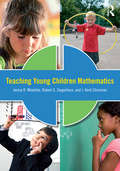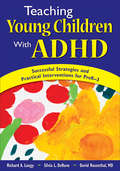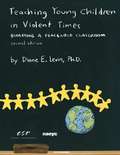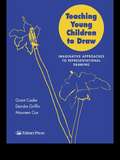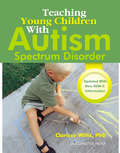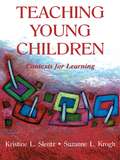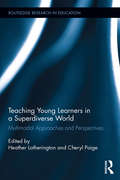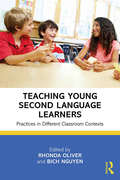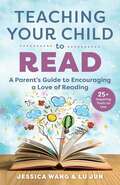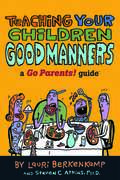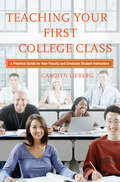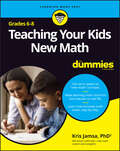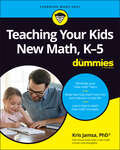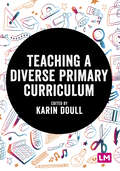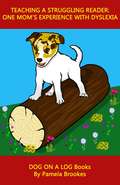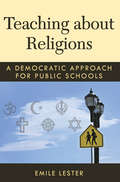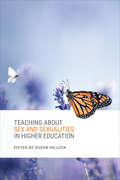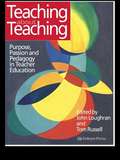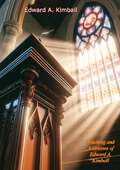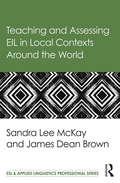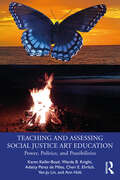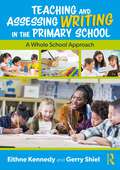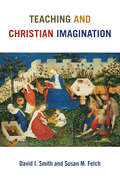- Table View
- List View
Teaching Young Children Mathematics
by Janice Minetola Robert G. Ziegenfuss J. Kent ChrismanTeaching Young Children Mathematics provides a comprehensive overview of mathematics instruction in the early childhood classroom. Taking into account family differences, language barriers, and the presence of special needs students in many classrooms throughout the U.S., this textbook situates best practices for mathematics instruction within the larger frameworks of federal and state standards as well as contemporary understandings of child development. Key topics covered include: developmental information of conceptual understanding in mathematics from birth through 3rd grade, use of national and state standards in math, including the new Common Core State Standards, information for adapting ideas to meet special needs and English Language Learners, literacy connections in each chapter, ‘real-world’ connections to the content, and information for family connections to the content.
Teaching Young Children With ADHD: Successful Strategies and Practical Interventions for PreK-3
by David Rosenthal Silvia L. Deruvo Richard A. LougyProvides teachers with an understanding of ADHD and how it manifests in young children, clarifying the what, why, and how of inclusive strategies that work.
Teaching Young Children in Violent Times: Building a Peaceable Classroom (Second Edition)
by Diane E. LevinA required book for early childhood educators, parents, and policy makers as it helps teachers create a Peaceable Classroom, where children learn peaceful alternatives to the violent behaviors modeled for them in society. <P><P>This extensively revised and updated edition features new material for a post-September 11th world including a new chapter on helping children deal with violence in the news.
Teaching Young Children to Draw: Imaginative Approaches to Representational Drawing
by Grant Cooke Mr Grant Cooke Dr Maureen Cox Maureen Cox Deirdre GriffinFirst published in 1997. Routledge is an imprint of Taylor & Francis, an informa company.
Teaching Young Children with Autism Spectrum Disorder
by Clarissa WillisWhat do you do when a three-year-old with autism falls on the floor kicking and screaming? How do you communicate with a child who looks away and flaps his hands? Who can help if you suspect a child in your class has autism? Preschool can be overwhelming for a child with autism. Autism affects how a child communicates, behaves, and relates to others. Teachers need to know what they can do to help children with autism reach their full potential. Teaching Young Children With Autism Spectrum Disorder is a straightforward, easy-to-understand guide to working with children who have autism. It explains the major characteristics associated with autism and helps teachers understand the ways children with autism relate to the world. Each chapter offers specific strategies for teachers to use, including setting up a proactive preschool environment, helping children learn life skills, managing behavior, helping children with autism communicate, encouraging children with autism to play, helping them to get along with others, and working with families. Teaching Young Children With Autism Spectrum Disorder helps teachers connect with all children in meaningful ways, allowing children with autism to learn and grow. Updated with new DSM-5 information.
Teaching Young Children: Contexts for Learning
by Suzanne L. Krogh Kristine SlentzUsing play as the method against which all others are compared, this book presents the strengths and weaknesses of different models of teaching, examines various methods of guiding young children's behavior, and shows how to create and maintain a positive learning environment. Finally, it discusses how to work as a team member in ECE settings.
Teaching Young Learners in a Superdiverse World: Multimodal Approaches and Perspectives (Routledge Research in Education #190)
by Heather Lotherington Cheryl PaigeThis book documents a collaborative action research project in one school where researchers and practitioners worked together to develop multimodal literacies and pedagogies for diverse, multilingual elementary classrooms. Following chronologically from Lotherington’s Pedagogy of Multiliteracies (2011), this volume picks up after teachers and researchers have learned how to work efficiently as a learning community to offer project-based learning approaches. This edited collection relates how teachers and students of different grade levels, language backgrounds, and abilities developed a shared agenda and created a framework for effective and inclusive practices. Contributors demonstrate that collaboration, creative pedagogical solutions and innovative project-based learning are all essential parts of learning and teaching socially appropriate and responsive literacies in a multimodal, superdiverse world.
Teaching Young Second Language Learners: Practices in Different Classroom Contexts (Language Learning And Language Teaching Ser. #23)
by Rhonda Oliver Bich NguyenAdopting a learner-centred approach that places an emphasis on hands-on child SL methodology, this book illustrates the practices used to teach young second language learners in different classroom contexts: (1) English-as-an-Additional-Language-or-Dialect (EAL/D) – both intensive EAL/D and EAL/D in the mainstream (2) Language-Other-Than-English (LOTE) (3) Content-and-Language-Integrated-Learning (CLIL), (4) Indigenous (5) Foreign-Language (FL). It will be particularly useful to undergraduate teachers to build upon the literacy unit they undertake in the first years of their course to explore factors that constitute an effective child SL classroom and, in practical terms, how to develop such a classroom. The pedagogical strategies for teaching young language learners in the six chapters are firmly guided by research-based findings, enabling not only pre-service teachers but also experienced teachers to make informed choices of how to effectively facilitate the development of the target language, empowering them to assume an active and effective role of classroom practitioners.
Teaching Your Child to Read: A Parent's Guide to Encouraging a Love of Reading
by Jessica Wang Lu JunIs your young child often disinterested in the books you bring home for them? Do you wish they would develop a love for reading that they could take into middle school and beyond? Some children love reading, requesting the same books over and over again and giggling with delight each time, while others simply despise sitting down for story time. What makes the difference in these two types of children? No child is born knowing how to read, so where does their interest come from? How do you encourage it? Like eating and drinking, reading is a daily necessity for every child. Parents should consciously guide and conform to their children&’s interest in reading with appropriate reading materials whenever possible. Books should take priority over watching television and playing video games. Professional and systematic training can help children start to love reading, maintain good reading habits, and improve their reading ability.Teaching Your Child to Read is a guide book for parents looking to get their children, ages 3 to 6, interested in reading. It explains how to help children cultivate reading ability step by step, as well as answers the questions of Why should I? and How do I? when it comes to specific exercises. Tools parents will learn to use in their efforts include:interval questioningobject comparingemotional contrastingplot mappingand more!
Teaching Your Children Good Manners (a Go Parents! Guide®)
by Lauri Berkenkamp Steven C. AtkinsFor parents everywhere who have had lovely family dinners ruined by misbehaving children, help is at hand. This guide provides a humorous, hands-on, parent-friendly approach to teaching children of all ages good manners in a wide variety of social situations, from accepting gifts graciously to which foods are OK to eat with fingers. Each chapter tackles a different situation, gives a brief outline of what manners are appropriate for it, and offers advice on how to teach and reinforce them to children of different ages. There is also a "What to Expect" chart broken down by age, and a Q & A section devoted to questions concerning children and manners.
Teaching Your First College Class: A Practical Guide for New Faculty and Graduate Student Instructors
by Carolyn LiebergNo other teaching experience will feel quite like the first time an instructor walks into a classroom to face a class of students.This book is a wise and friendly guide for new faculty and graduate student instructors who are about to teach for the first time. It provides an introduction to the theory of teaching; describes proven strategies and activities for engaging students in their learning; and offers advice on classroom management, syllabus creation, grading, assessment, and discipline issues, among other topics. It prepares readers for a confident start as teachers, and gives them a firm foundation on which to develop their skills and personal classroom styles.The author breaks teaching down into its component elements and tasks to enable graduate student instructors to identify their particular responsibilities, and learn about what works and does not. They will also benefit from reading the book as a whole as it sets their work in the context of course objectives and learning theory.For new faculty this engaging book provides a solid basis from which to develop their skills and personal styles as teachers; and offers guidance on documenting their classroom success for the purposes of promotion and tenure. For graduate student instructors, the book is a companion that will give them confidence and pleasure in teaching, and stand them in good stead if they decide on a in any future career in academe.
Teaching Your Kids New Math, 6-8 For Dummies
by Kris JamsaIt’s not too late to learn new math tricks—and help kids learn them, too! Teaching Your Kids New Math, Grades 6-8, For Dummies teaches you the new standard way of teaching kids math. It’s all about thinking through how to solve problems and using strategies, rather than just memorizing the procedures. In this book, parents, guardians, and tutors will learn how to use these methods and standards to effectively teach kids Common Core math for grades 6-8. Teaching Your Kids New Math, Grades 6-8, For Dummies shows you how schools are teaching kids math these days, and gives you tools to support kids through the homework and test prep process. You’ll love this book’s clear explanations and examples organized by grade level. With Teaching Your Kids New Math, Grades 6-8, For Dummies?? you’ll also get access to online tools, including dozens of math worksheets for additional support. Learn how to teach 6th through 8th grade math according to the Common Core Discover the new methods and formulas that are standard for math instruction Get best teaching practices, example problems, and tips about common math pitfalls Help your kids with math homework and enhance the homeschool journeyThis is the perfect Dummies guide for anyone who needs guidance on how to teach kids math using new methods and concepts—they’re different from what we learned in school! Future math teachers will also love this user-friendly guide to middle-grade math.
Teaching Your Kids New Math, K-5 For Dummies
by Kris JamsaHelp your child unlock their math potential with this intuitive guide to teaching new math Teaching Your Kids New Math, K-5 For Dummies makes it easy to understand the new math being taught to students in kindergarten to Grade 5, showing parents and guardians how to help their kids with the new methods and concepts that have been introduced since they finished school. You’ll discover the math-teaching basics you need to help your kids with their math homework while becoming familiar with the grids, arrays, diagrams, and arrows that math students use today. You’ll also get: A step-by-step walkthrough for teaching young students essential math concepts, even if you think you’re not a “math person” Best practices, example problems, and tips and tricks about specific math topics that will help your youngster move forward Ways to avoid common and typical math pitfalls and frustrations that trap math students and teachers Full of real-world examples and applications, Teaching Kids New Math, K-5, For Dummies is your essential companion to helping your child master their math assignments and have fun while you’re doing it!
Teaching a Dark Chapter: History Books and the Holocaust in Italy and the Germanys
by Daniela R. WeinerTeaching a Dark Chapter explores how textbook narratives about the Fascist/Nazi past in Italy, East Germany, and West Germany followed relatively calm, undisturbed paths of little change until isolated "flashpoints" catalyzed the educational infrastructure into periods of rapid transformation. Though these flashpoints varied among Italy and the Germanys, they all roughly conformed to a chronological scheme and permanently changed how each "dark past" was represented. Historians have often neglected textbooks as sources in their engagement with the reconstruction of postfascist states and the development of postwar memory culture. But as Teaching a Dark Chapter demonstrates, textbooks yield new insights and suggest a new chronology of the changes in postwar memory culture that other sources overlook. Employing a methodological and temporal rethinking of the narratives surrounding the development of European Holocaust memory, Daniela R. P. Weiner reveals how, long before 1968, textbooks in these three countries served as important tools to influence public memory about Nazi/Fascist atrocities. As Fascism had been spread through education, then education must play a key role in undoing the damage. Thus, to repair and shape postwar societies, textbooks became an avenue to inculcate youths with desirable democratic and socialist values. Teaching a Dark Chapter weds the historical study of public memory with the educational study of textbooks to ask how and why the textbooks were created, what they said, and how they affected the society around them.
Teaching a Diverse Primary Curriculum (Exploring the Primary Curriculum)
by Karin DoullWithout conscious consideration of diversity in the curriculum, there is a danger that teachers fall back on a narrow syllabus. Trainee and new teachers need support to expand their knowledge and understanding of the curriculum to enable them to make active choices to ensure diversity in what they teach. This book explains why and how diversity can be taught through the primary National Curriculum. It includes practical examples of good practice and realistic straightforward ideas and resources to support new teachers to go into the classroom ready to bring diverse voices and learning to their teaching.
Teaching a Diverse Primary Curriculum (Exploring the Primary Curriculum)
by Karin DoullWithout conscious consideration of diversity in the curriculum, there is a danger that teachers fall back on a narrow syllabus. Trainee and new teachers need support to expand their knowledge and understanding of the curriculum to enable them to make active choices to ensure diversity in what they teach. This book explains why and how diversity can be taught through the primary National Curriculum. It includes practical examples of good practice and realistic straightforward ideas and resources to support new teachers to go into the classroom ready to bring diverse voices and learning to their teaching.
Teaching a Struggling Reader: One Mom's Experience with Dyslexia (DOG ON A LOG Books #1)
by Pamela BrookesThere are a lot of children (and adults) who struggle with reading. Some are helped by their schools, some are not. <P><P>In this short booklet, Pamela Brookes shares some of the basic information she wishes she'd had when she was first trying to figure out how to help her child learn to read. <P><P>Teaching A Struggling Reader is filled with links to informational and product resources for parents or teachers. It is geared to people who want to educate themselves in the methods that are effective in teaching those with dyslexia. It also contains photos demonstrating basic techniques like "Tapping" (using one's fingers to aid in sounding out words) and "Making your bed" to differentiate between "b" and "d." <P><P>This Second Edition includes new information and new links. Most importantly it has information on Early Intervention, including what parents can do if they suspect their child may have dyslexia during the toddler and preschool years, and a new section on What if It's NOT Dyslexia. <P><P>The focus of this book is the reading process. However, since many readers with dyslexia also struggle with math, there is a brief description of how the dyslexic brain comes to understand math. There is also a link to a blog by Dr. Meg Burke of Dyslexia Pros. She has dyslexia and a PhD in math education. She is dedicated to helping her students attain fluency in math. <P><P>This is a booklet that can be read in one sitting. However, there are ample links to provide an even greater experience.
Teaching about Religions: A Democratic Approach for Public Schools
by Emile Lester"This provocative and timely book challenges Americans to rethink what it means to take democracy and religious freedom seriously in public education. Emile Lester takes the reader beyond culture war conflicts rooted in religious divisions and offers bold, new solutions for addressing our differences with fairness and robust toleration. Instead of battlegrounds, he argues, public schools can and should be places that include all voices in ways that prepare citizens to engage one another with civility and respect. Teaching about Religionsis essential reading for all who care about the future of public schools---and the health of American democracy. " --- Charles C. Haynes, Senior Scholar, Freedom Forum First Amendment Center "More than simply a synthesis of existing scholarship, [this book is] an original contribution to the field. [The] major themes are timely, and this book might well contribute to public discussion of important issues in our culture wars. " ---Warren Nord, University of North Carolina-Chapel Hill "Arriving in the wake of a bitter battle over the place of Islam in America and in the midst of calls for greater understanding and civility, Emile Lester's new book is a timely contribution to the debate about the best ways to teach about religion in our nation's public schools. A pioneering researcher in this field, Lester offers thoughtful critiques of existing proposals as well as fresh ideas. His recommendations reflect painstaking efforts to understand the concerns of groups (most notably, conservative Christians) to which he does not belong, and a firm grasp of the difference between fostering understanding of other faiths and pressing for acceptance of them. Lester's prescriptions, always informed and fair-minded and sometimes provocative, should drive the debate forward in productive ways. " ---Melissa Rogers, Director, Center for Religion and Public Affairs at Wake Forest University School of Divinity and Nonresident Senior Fellow, The Brookings Institution Frequent news stories about the debates waged between secularists and religious conservatives have convinced most Americans that public schools must choose between promoting respect for religious minorities and respecting the interests of conservative Christians. As a result, public schools fail to teach students about the meaning and value of protecting religious liberty and consequently perpetuate mistrust across the cultural divide, further empower extremists, and obscure the fact that most Americans of all religious backgrounds share a commitment to basic democratic principles. In response, the public schools in the religiously diverse and divided community of Modesto, California, have introduced a widely acclaimed required world religions course. Drawing on groundbreaking research on the creation of and response to the Modesto course as well as on political philosophy, Emile Lester advocates a civic approach to teaching about religion in public schools that at once emphasizes respect for all views about religion and provides a special recognition of conservative Christian beliefs.
Teaching about Sex and Sexualities in Higher Education
by Susan HillockTeaching about Sex and Sexualities in Higher Education argues that much more can be done in teaching about sex and sexuality in higher education. This edited collection provides key information on professional training and support, and acts as a crucial resource on sex, sexuality, and related issues. With a focus on diversity, this book features expert contributors who discuss key concepts, debates, and current issues across disciplines to help educators improve curriculum content. This collection aims to provide adequate and appropriate sex education training and opportunities to educators so that they may explore complex personal and emotional issues, build skills, and develop the confidence necessary to help others in their respective fields.
Teaching about Teaching: Purpose, Passion and Pedagogy in Teacher Education
by Tom RussellConsiders teacher education as an important aspects of the teaching profession and demonstrates why it is so important for higher education institutions to value their teacher educators' professional knowledge. The book demonstrates how teaching about teaching knowledge pedagogy is vital to the development of quality in teacher education and how this knowledge needs to be articulated and communicated throughout the teaching profession, both in schools and universities.
Teaching and Addresses of Edward A. Kimball
by Edward A. KimballExplore the profound insights and transformative teachings of one of Christian Science’s most influential figures with Teaching and Addresses of Edward A. Kimball. This compelling collection brings together the essential writings and speeches of Edward A. Kimball, offering readers a deep dive into the spiritual wisdom and practical guidance that have inspired countless individuals on their spiritual journeys.Edward A. Kimball, a prominent Christian Science teacher and lecturer, was known for his clear and compelling articulation of the principles of Christian Science. This anthology captures the essence of his teachings, providing a comprehensive overview of his views on spiritual healing, faith, and the application of Christian Science principles to everyday life.Teaching and Addresses of Edward A. Kimball covers a wide range of topics, from the foundational beliefs of Christian Science to practical advice on how to live a spiritually enriched and healthful life. Kimball’s writings emphasize the importance of understanding the divine laws of God, the nature of true health and harmony, and the power of spiritual thought to effect positive change.The book is organized to present Kimball’s teachings in a coherent and accessible manner, making it an invaluable resource for both newcomers to Christian Science and those seeking to deepen their understanding of its principles. His eloquent addresses and insightful essays provide readers with a roadmap for spiritual growth, encouraging them to cultivate a closer relationship with God and to experience the healing power of divine Love.This Book is an essential addition to the library of anyone interested in Christian Science, spiritual healing, and the pursuit of a deeper understanding of divine truth. Edward A. Kimball’s legacy of wisdom and compassion continues to guide and uplift readers, offering timeless insights into the path of spiritual enlightenment and healing.
Teaching and Assessing EIL in Local Contexts Around the World (ESL & Applied Linguistics Professional Series)
by Sandra Lee Mckay James Dean BrownEnglish today is a global language embedded in a great variety of social contexts, resulting in linguistic and pedagogical variation. Taking a new look at the teaching and assessing of English as an international language (EIL), this text highlights overarching principles and provides specific strategies for responding to questions and challenges posed by the changing demographics of English language learners and users around the world. Teaching and Assessment in EIL Classrooms introduces an original, coherent framework in which needs analysis, pedagogical principles, and assessment are integrated describes variables that influence effective teaching and assessment and the characteristics of various EIL teachers and learners emphasizes that pedagogical and assessment decisions need to be based on the learning and teaching needs of each specific EIL context includes specific principles and strategies for teaching and assessing grammar, oral language, and literacy skills in EIL classrooms provides strategies for integrating computer-mediated language into EIL classrooms in ways that promote cross-cultural awareness, language development, and individualized learning Timely, accessible, and practical, this text for graduate and pre- and in-service courses on language teaching and assessment is at the forefront in providing valuable information and guidance for enabling principled and context-sensitive praxis in EIL classrooms worldwide.
Teaching and Assessing Social Justice Art Education: Power, Politics, and Possibilities
by Ann Holt Karen Keifer-Boyd Wanda B. Knight Adetty Pérez de Miles Cheri E. Ehrlich Yen-Ju LinThis incisive and wholly practical book offers a hands-on guide to developing and assessing social justice art education for K–12 art educators by providing theoretically grounded, social justice art education assessment strategies. Recognizing the increased need to base the K–12 curriculum in social justice education, the authors ground the book in six social justice principles–conceptualized through art education–to help teachers assess and develop curriculum, design pedagogy, and foster social justice learning environments. From encouraging teachers to be upstanders to injustice to engaging in decolonial action, this book provides a thorough guide to facilitating and critiquing social justice art education and engaging in reflexive praxis as educators. Rich in examples and practical application, this book provides a clear pathway for art educators to connect social justice art education with real-life educational assessment expectations: 21st-century learning, literacy, social skills, teacher performance-based assessment, and National Core Art Standards, making this text an invaluable companion to art educators and facilitators alike
Teaching and Assessing Writing in the Primary School: A Whole School Approach
by Eithne Kennedy Gerry ShielThe capacity to write well is fundamental to success in school and beyond. Yet many children struggle to become proficient writers. Teaching and Assessing Writing in the Primary School provides a comprehensive guide to the theory, practice and pedagogical research behind teaching children to write. Supported by case studies and real-world examples of teaching and learning writing in the classroom, this practical book proposes a whole-school, research-informed writing framework that engages children while building their writing skills. Readers will benefit from building their knowledge of the theory and research behind learning how to write successfully while discovering how they may apply this effectively to their classroom practice.Firmly grounded in the theory of writing and with clear links to practical application, chapters explore: Effective pedagogies for teaching children aged 4–12 how to write The planned and received curriculum for writing, including a whole-school approach Formative and summative assessment of writing in the classroom Designing and organising a Writing Workshop for pupils Practical implementation of ‘mini lessons’ to support writing Supporting the needs of diverse writers within our schools Filled with strategies for teaching, this practical and engaging book will be an essential resource for anyone working within primary schools, including classroom teachers (both new and more experienced), teaching assistants, subject leaders, literacy coordinators and senior leadership.
Teaching and Christian Imagination
by David I. Smith Susan M. FelchThis book offers an energizing Christian vision for the art of teaching. The authors — experienced teachers themselves — encourage teacher-readers to reanimate their work by imagining it differently. David Smith and Susan Felch, along with Barbara Carvill, Kurt Schaefer, Timothy Steele, and John Witvliet, creatively use three metaphors — journeys and pilgrimages, gardens and wilderness, buildings and walls — to illuminate a fresh vision of teaching and learning. Stretching beyond familiar clichés, they infuse these metaphors with rich biblical echoes and theological resonances that will inform and inspire Christian teachers everywhere.
